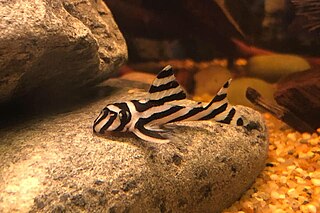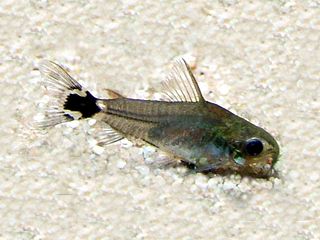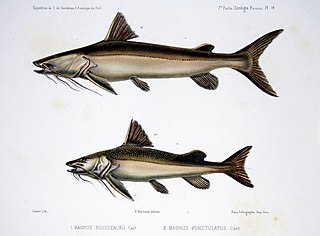
Catfish are a diverse group of ray-finned fish. Named for their prominent barbels, which resemble a cat's whiskers, catfish range in size and behavior from the three largest species alive, the Mekong giant catfish from Southeast Asia, the wels catfish of Eurasia, and the piraíba of South America, to detritivores, and even to a tiny parasitic species commonly called the candiru, Vandellia cirrhosa. Neither the armour-plated types nor the naked types have scales. Despite their name, not all catfish have prominent barbels or "whiskers". Members of the Siluriformes order are defined by features of the skull and swimbladder. Catfish are of considerable commercial importance; many of the larger species are farmed or fished for food. Many of the smaller species, particularly the genus Corydoras, are important in the aquarium hobby. Many catfish are nocturnal, but others are crepuscular or diurnal.

The iridescent shark or iridescent shark catfish is a species of shark catfish native to the rivers of Southeast Asia. Despite its name, it is not a shark. It is found in the Mekong basin as well as the Chao Phraya River, and is heavily cultivated for food there.

Corydoras is a genus of freshwater catfish in the family Callichthyidae and subfamily Corydoradinae. The species usually have more restricted areas of endemism than other callichthyids, but the area of distribution of the entire genus almost equals the area of distribution of the family, except for Panama where Corydoras is not present. Corydoras species are distributed in South America where they can be found from the east of the Andes to the Atlantic coast, from Trinidad to the Río de la Plata drainage in northern Argentina.

The walking catfish is a species of freshwater airbreathing catfish native to Southeast Asia. It is named for its ability to "walk" and wiggle across dry land, to find food or suitable environments. While it does not truly walk as most bipeds or quadrupeds do, it can use its pectoral fins to keep it upright as it makes a wiggling motion with snakelike movements to traverse land. This fish normally lives in slow-moving and often stagnant waters in ponds, swamps, streams, and rivers, as well as in flooded rice paddies, or temporary pools that may dry up. When this happens, its "walking" skill allows the fish to move to other aquatic environments. Considerable taxonomic confusion surrounds this species, and it has frequently been confused with other close relatives. One main distinction between the walking catfish and the native North American ictalurid catfish with which it is sometimes confused, is that the walking catfish lacks an adipose fin. It can survive 18 hours out of water.

The Cetopsidae are a small family of catfishes, commonly called the whale catfishes.

Basa, as it is commonly referred to, is a species of primarily freshwater-dwelling catfish in the shark-catfish family, Pangasiidae, native to the Mekong and Chao Phraya river basins of Mainland Southeast Asia. Economically, these fish are important as a regional food source, and are also prized on the international market. Outside of Asia, such as in North America or Australia, they are often referred to as "basa fish" or "swai" or by their specific name, "bocourti". In the United Kingdom, all species of Pangasius may, legally, be described as "river cobbler", "cobbler", "basa", "pangasius" or simply "panga", as well as any of these names with the addition of "catfish". In the rest of mainland Europe, these fish are mostly sold as "pangasius" or "panga". In Asian fish markets, names for basa also include "Pacific dory" and "patin". Other, related shark-catfish species may occasionally be labeled—albeit incorrectly—as basa, including the iridescent shark and the yellowtail catfish.

The zebra pleco is a species of catfish endemic to a small section of the Rio Xingu in Brazil. It occurs in the big bend area of the river, downstream from the town of Altamira, Para. It was first described in 1991. It gets its name from its black and white stripes, resembling the colouration of a zebra. This species grows to a length of 6.4 centimetres (2.5 in) SL. This species was exported from Brazil in 1987 for sale as aquarium fish. However, currently, the Brazilian government bans the export of certain fish species, including H. zebra.

The redtail catfish, is a large species of South American pimelodid (long-whiskered) catfish. It is known in Venezuelan Spanish as cajaro; in Guyana, it is known as a banana catfish, and in Brazil it is known as pirarara, a fusion of words from the indigenous Tupi language: pirá and arara. It is the only extant species of its genus, Phractocephalus.

The dwarf corydoras, dwarf catfish, tail spot pygmy catfish, or micro catfish is a tropical freshwater fish belonging to the subfamily Corydoradinae of the family Callichthyidae. It originates in inland waters in South America, and is found in the Amazon River and Paraguay River basins in Argentina, Bolivia, and Brazil. The specific epithet hastatus means with a spear, in reference to the spearhead-like spot on the tail root.

Brachyplatystoma is a genus of catfish from the family Pimelodidae. As the occasionally used common name goliath catfishes indicates, this genus includes some of the largest species of catfish, including the piraíba, B. filamentosum, which reaches up to 3.6 metres (12 ft) in length; though the other species don't reach this length. Brachyplatystoma are found in the Amazon and Orinoco basins, and other tropical freshwater and brackish habitats in South America. Many species are migratory. These fish are important as food fish and, to some extent, aquarium fish.

Hemibagrus wyckioides, the Asian redtail catfish, is a species of catfish of the family Bagridae.

Pareiodon microps is a species of catfish of the family Trichomycteridae, and the only species of the genus Pareiodon. It is endemic to Brazil where it occurs in the Amazon Basin.
Cetopsis is a genus of catfishes of the family Cetopsidae.

Pareutropius debauwi is a species that belong to the Order Actinopterygii, ray-finned fishes, and can be placed in the Schilbeidae family, Schilbid catfishes. This family includes 9 genera and 46 species. The common name for Pareutropius debauwi is the African glass catfish.

Pterygoplichthys pardalis, the Amazon sailfin catfish, is a freshwater tropical fish in the armored catfish family (Loricariidae). It is one of a number of species commonly referred to as the common pleco or "leopard pleco" by aquarists.It can be called 豹紋翼甲鯰 in Mandarin Chinese.

Rineloricaria lanceolata, commonly known as the chocolate-colored catfish or the chocolate whiptail catfish, is a species of catfish in the family Loricariidae. It is native to South America, where it occurs in the upper Amazon River basin in Brazil and Peru. It is reportedly typically found in sandy environments with leaf litter. It is omnivorous, feeding on periphyton and small invertebrates. The species reaches 12.3 cm in total length and is believed to be a facultative air-breather.

Cetopsis candiru, also known as candiru, candiru açú, candiru cobra or canero, is a carnivorous species of whale catfish found in the Amazon basin of Peru, Brazil and Bolivia. Similar to Cetopsis coecutiens, Cetopsis candiru is a large species of the genus Cetopsis and a widespread scavenger, known for its voracious feeding and the habit of burrowing into the carcasses of dead animals and humans. Despite its name, it is not closely related to the bloodsucking Candiru.

Brachyplatystoma filamentosum, commonly called piraíba, kumakuma, valentón or lau lau, is a species of catfish of the family Pimelodidae and genus Brachyplatystoma that is native to Amazon and Orinoco River basins and rivers in the Guianas and northeastern Brazil. It is an important predator in its ecosystem, and in turn is a food fish.

Brachyplatystoma rousseauxii, the gilded catfish or dourada, is a species of catfish of the family Pimelodidae that is native to the Amazon and Orinoco River basins and major rivers of French Guiana.

















